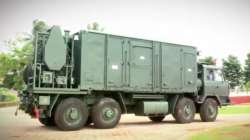DRDO develops 6 more location radar weapons SWATHI, to be procured by Indian Army soon
The Defence Research and Development Organisation (DRDO) developed six more locating radars Swathi weapons. Meanwhile, these powerful weapons will be procured by the Indian Army soon. This is a powerful weapon that can easily distinguish between friends and foes.

The Defence Research and Development Organisation (DRDO) developed six more locating radars Swathi weapons. Meanwhile, these powerful weapons will be procured by the Indian Army soon. This is a powerful weapon that can easily distinguish between friends and foes. It's 400 crore projects taken up by the Ministry of Defence and it will enhance the capabiity of the Indian Army.
Here are some features of Weapon Location Radar (WLR) – SWATHI
- Detection of launch point of enemy Shells, Mortars and Rockets
- Guide own artillery fire at enemy targets to achieve fire supremacy in the battlefield
- Tracks from launch to impact point of all types of targets
- Self-sufficient with own north finding system and GPS to find own location
- Slewable Phased Array Antenna
- Communication with higher echelons
- Low encamp and decamp time
- Weapon locating in high density fire environment
- Programmable state-of-the-art hardware based processing
This weapon is designed and developed by Electronics and Radar Development Establishment (LRDE), Bengaluru. SWATHI-Weapon Location Radar was handed over to Indian Army in March 2017. Swathi Weapon Location Radar (WLR) is indigenously developed, coherent, electronically scanned phased array radar. The radar automatically locates hostile artillery, mortars and rocket launchers and tracks friendly fire to locate the impact point to issue necessary corrections.
The radar is designed to detect projectiles with small cross section across the battle space horizon, and has the capability to handle simultaneous fire from weapons deployed at multiple locations. WLR has two roles to perform: Weapon Location Mode for Enemy Artillery and Direction of Own Artillery Fire (DOOAF) Mode. The key technologies include Gun Launch Point Computation, Digital Pulse Compression, Digital Receiver with Waveform Programming, UML based Software Development and efficient thermal management using Compact Light Weight Intelligent Cooling Systems.